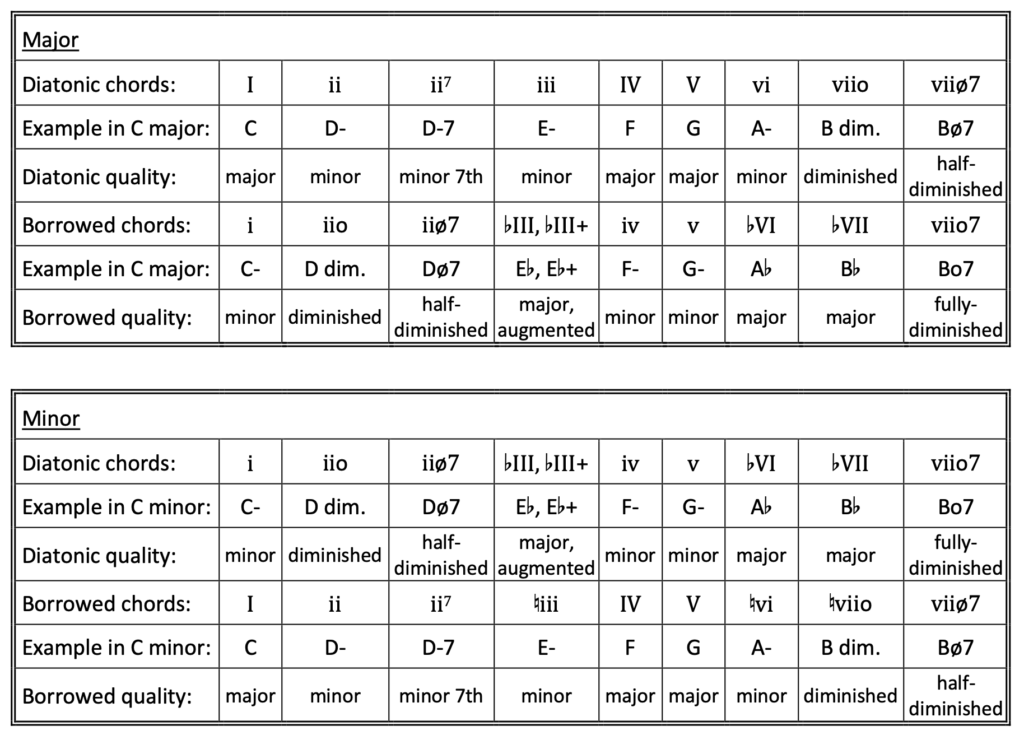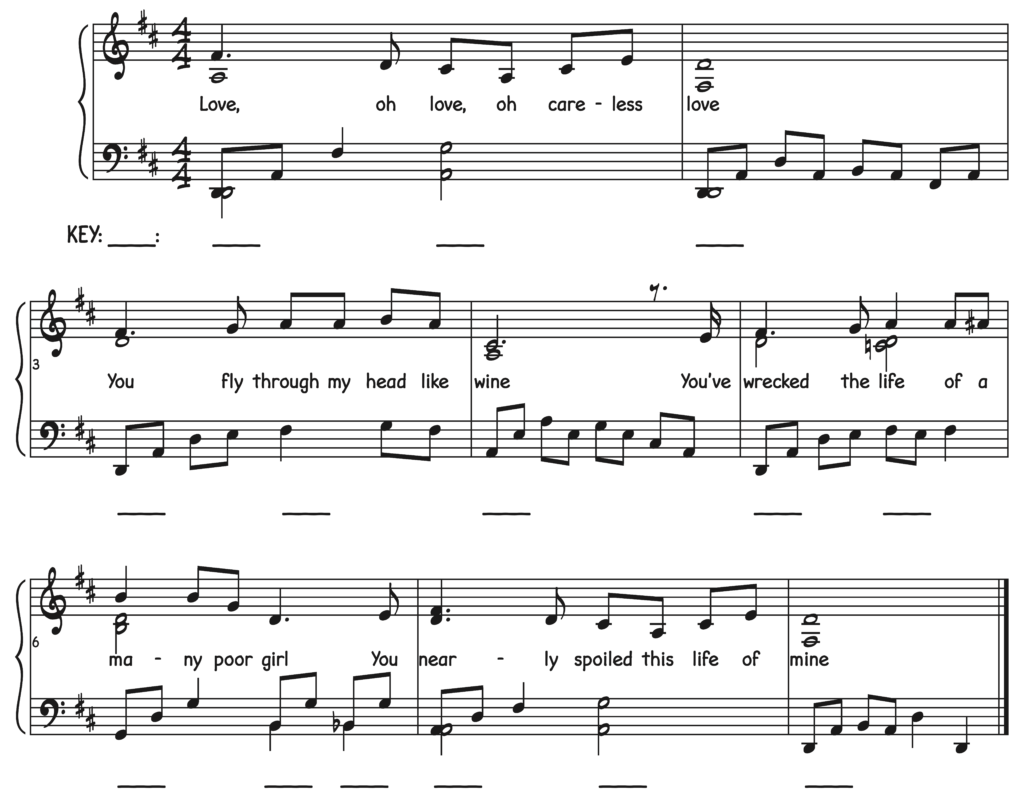Main Body
40 Mode mixture
Learning goals for Chapter 40
In this chapter, we will learn:
- How to identify and other instances of in musical contexts, aurally and visually in musical notation
- How to spell borrowed chords
Mode mixture
refers to the use of chords that exist in the major or minor mode. You may already be familiar with mode mixture in a handful of situations, such as the Picardy third (the major tonic chord at a cadence in a piece that is otherwise in a minor key) and the major dominant chord (V) in a minor key.
Mode mixture can occur at various levels in music. On a local level, individual chords may be borrowed from the parallel minor or major mode. We call these instances . Sometimes more material is based on the parallel major or minor: a group of chords, or even an entire phrase or section of music. Figure 40‑1 outlines the possible diatonic and borrowed chords in major and minor keys.
Figure 40‑1. Diatonic and borrowed chords
Of all possibilities, borrowed chords are by far the most common (iio, iiø7, and iv) usually found in a major key, borrowing from the minor. These add a special color and marked pathos to chord progressions in major keys that would otherwise sound ordinary.
Examples of borrowed chords
Example 40‑1, in a major key, uses one of the most common predominant borrowed chords, the borrowed subdominant triad from the parallel minor mode. In the fourth measure of the first phrase (0:09–0:22), the melody is harmonized with a diatonic subdominant chord (B![]() major in the key of F major). The melody appears again later in 0:48–1:02, but now re-harmonized. Notice the borrowed subdominant (B
major in the key of F major). The melody appears again later in 0:48–1:02, but now re-harmonized. Notice the borrowed subdominant (B![]() minor) in the fourth measure of the re-harmonization.
minor) in the fourth measure of the re-harmonization.
Example 40‑1. Annotated transcription of Richard Rodgers and Oscar Hammerstein II, “Edelweiss” from The Sound of Music, as performed on the Original Broadway Cast Recording, 0:09–0:22 and 0:48–1:02
Audio for 0:09–0:22
Audio for 0:48–1:02
Listen to the full track on Spotify.
Learn about American composer Richard Rodgers (1902–1979) by reading this Oxford Music Online article, written by Geoffrey Block.
Example 40‑2, also in a major key, uses the borrowed supertonic seventh chord, another common borrowed predominant. The German text of this passage translates in English to “I bear no grudge, even though my heart breaks.” We hear the expressive borrowed iiø7 on the word “Herz,” which means “heart” in German.
Example 40‑2. Robert Schumann, “Ich grolle nicht” from Dichterliebe, mm. 1–4
Listen to the full track, performed by Dietrich Fischer-Dieskau, on Spotify.
Learn about German composer Robert Schumann (1810–1856) by reading this Oxford Music article, written by John Daverio and Eric Sams.
Example 40‑3 presents a compelling borrowed subdominant chord in the key of E![]() major. In this excerpt, the borrowed minor iv (A
major. In this excerpt, the borrowed minor iv (A![]() minor) harmonizes the words “nothing really matters” in an otherwise major key context.
minor) harmonizes the words “nothing really matters” in an otherwise major key context.
Example 40‑3. Queen, “Bohemian Rhapsody,” 1:29–1:47
Listen to the full track on Spotify.
Learn about 20th-century English rock band Queen fronted by Freddie Mercury (1946–1991) by reading this Oxford Music Online article, written by David Laing.
Example 40‑4 uses a repeating that features two chromatic chords. The repeating progression throughout the recording is G major – B major – C major – C minor. The final chord (C minor) is the borrowed minor subdominant chord (iv) in the overall key of G major. The B major chord is also chromatic, and it functions as a secondary dominant (V/vi) that resolves deceptively (VI/vi). It is also a chromatic mediant in relationship to the tonic triad.
Example 40‑4. Radiohead, “Creep,” 0:00–0:23
Listen to the full track on Spotify.
Learn about English rock band Radiohead by reading this Oxford Music Online article, written by Christopher Doll.
Video: T73 Mode mixture and borrowed chords (12:51)
This video explores the concept of and identifies in music by Rodgers and Hammerstein, Robert Schumann, Queen, and Radiohead (Examples 40-1, 40-2, 40-3, and 40-4).
EXERCISE 40-1 Chord spelling
Provide the key signature for each of the specified keys below. Then, given the Roman numerals, spell each of the chords in the specified keys, using accidentals if needed. Finally, indicate whether the chord is (1) , and/or (2) a by checking the appropriate boxes below the staff. Some chords may not be either; others may be both.
EXERCISE 40-2 Analysis with borrowed chords
PART A. After studying and listening to the following excerpt, identify the key, then provide a Roman numeral analysis on the blanks provided. Circle the Roman numeral of all . Circle and label all , and answer these questions:
- Assuming there are two four-bar phrases in this piece, what term(s) best characterize the overall form of the excerpt and why?
- What kind of appears in this excerpt?
Worksheet example 40‑1. Traditional, “Careless Love”
Listen to a recording of this example, performed by Bessie Smith, on Spotify.[1]
Learn more about American singer Bessie Smith (1894–1937), by reading this Oxford Music Online article, written by Michael Meckna and revised by Richard Bernas.
PART B. Study and listen to the following excerpts and read the English translation of the text (poetry by Friedrich Rückert) beneath each excerpt. Then identify the key and provide a Roman numeral analysis for mm. 8–15 and mm. 54–65 on the blanks provided. Circle the Roman numeral of all borrowed chords. Circle and label all non-chord tones. Finally, compare the two passages (mm. 8–15 and mm. 54–65), and in several sentences, explain how these passages are related, especially with regard to harmony and chromaticism and the text of the song.
Worksheet example 40‑2. Franz Schubert, op. 59, no. 3, “Du bist die Ruh,” mm. 1–17
Listen to the full track, performed by soprano Barbara Bonney, on Spotify.
Learn about Austrian composer Franz Schubert (1797–1828) by reading this Oxford Music Online article, written by Maurice J. E. Brown and others.
Worksheet example 40‑3. Franz Schubert, op. 59, no. 3, “Du bist die Ruh,” mm. 53–65
Listen to the full track, performed by soprano Barbara Bonney, on Spotify.
Learn about Austrian composer Franz Schubert (1797–1828) by reading this Oxford Music Online article, written by Maurice J. E. Brown and others.
Supplemental materials for Chapter 40
- This recording uses a varied harmonization of the tune, but still features the striking borrowed chord. ↵
chromatic chord taken from the parallel minor or major mode
use of chromatic chords that exist diatonically in the parallel major or minor mode
term referring to notes outside of a key
term referring to notes within a key
the relationship between keys that have the same tonic, but a different key signature
a tonal function that typically precedes dominant function; chords with predominant function include the subdominant triad and chords built on scale degree 2
system of harmonic organization that uses a repeating chord progression, often four chords long
any major or minor triad whose root is related by major or minor third to tonic, and which contains at least one chromatic note; also refers to a key relationship in which the tonics are related by major or minor third and the keys are not closely related
notes that do not belong in a given chord; for example, D would be a non-chord tone in relationship to a C major triad
triad in second inversion, meaning the fifth of the chord is the lowest sounding note







